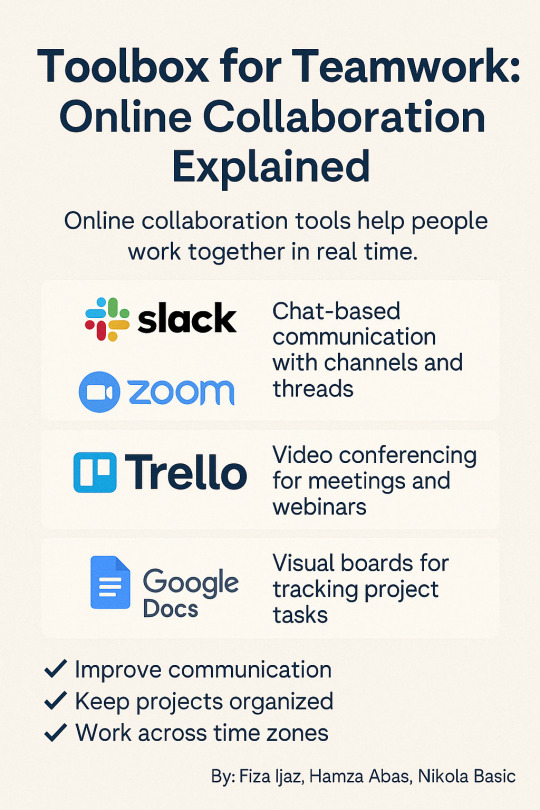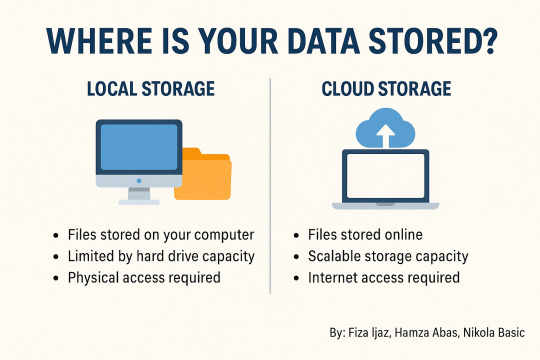This is the final project submission for CEID 100 from group 5.
Don't wanna be here? Send us removal request.
Text
Post 5: The Future is Now – AI, Hybrid Work & Digital Skills
Not only is technology advancing rapidly, but so is our method of working. Cloud computing, artificial intelligence (AI), and hybrid work models are already changing the definition of productivity and will define the next ten years of work.
The incorporation of AI into cloud-based platforms is one significant change. These days, programs like Google's AI helper for Docs and Sheets and Microsoft Copilot can auto-draft emails, propose changes, summarize meetings, and even rank your tasks according to importance. By decreasing repetitive tasks and enhancing decision-making, these solutions assist teams in working more efficiently and intelligently.
Hybrid work, a flexible arrangement where employees divide their time between the workplace and their homes, is another popular trend. Most businesses now allow hybrid schedules, but this model only functions with dependable digital technologies like Zoom, Slack, and cloud storage systems, according to Forbes and McKinsey.

Original Image, made in Canva
These trends are vital skills for students, not merely futuristic ideas. Companies are already searching for candidates that can:
Work together efficiently online.
Professionally oversee their online presence
Use AI sensibly and morally.
Safeguard private information and sensitive data.
Being proficient in digital skills will help you succeed in any field, including business, technology, healthcare, and the arts.
Since the future of work is not yet here, now is the time to familiarize yourself with the tools that will shape the workplace of the future. It has already arrived.
Sources:
Forbes. (2023, September 14). AI and the future of work: How artificial intelligence is transforming productivity. Forbes. https://www.forbes.com/councils/forbestechcouncil/2024/07/12/ai-and-the-future-of-work/
McKinsey & Company. (2024, January 22). The future of work: What automation and AI will mean for jobs, skills, and wages. McKinsey & Company. https://www.mckinsey.com/featured-insights/future-of-work/jobs-lost-jobs-gained-what-the-future-of-work-will-mean-for-jobs-skills-and-wages?
Radancy. (2024, March 8). The rise of hybrid work: Redesigning work-life balance for the future. Radancy. https://blog.radancy.com/2025/02/06/the-rise-of-hybrid-work-redesigning-work-life-balance/
Module 9 - I AM AI: Thinking machines
0 notes
Text
Post 4: Benefits, Challenges, and the Real World
A new era of flexibility and productivity has been made possible by cloud computing and collaborative capabilities. Digital technologies are now essential to how we interact and operate, whether it's students co-editing a Google Doc or a multinational corporation operating across continents. However, such benefits also come with some significant drawbacks.

Original image, Made in Canva
Benefits:
Enhanced Productivity: Teams may collaborate on documents, transfer data instantaneously, and communicate in real time from any location.
Reduced Operating Costs: Businesses can save money by doing away with the requirement for actual servers and spacious office premises.
Faster Decision-Making: Concepts get from debate to action more quickly with real-time updates and virtual meetings.
Challenges:
Cybersecurity Risks: Because sensitive information is kept online, weak security makes businesses easy targets for hackers.
Data privacy issues: With so much data moving through cloud services, user rights and privacy regulations get increasingly complicated.
Tech Burnout: For remote workers in particular, being "always online" can cause weariness and a blurring of work-life boundaries.
Real-World Examples: Google manages enormous data storage and improves internal cooperation among its worldwide teams by utilizing its own cloud services.
In 2020, Shopify, one of the biggest e-commerce businesses in Canada, turned entirely remote. Its success demonstrates how even big, complicated enterprises can be powered by cloud and collaborative tools.
Microsoft helps businesses adjust to the future of digital work by offering training and assistance in addition to platforms like Teams and Azure.
Businesses and students alike can make more informed judgments about the efficient—and responsible—use of technology by being aware of the hazards as well as the opportunities.
Sources:
Filestage. (2024, July 10). 16 best online collaboration tools (pros, cons, and costs). Filestage. https://filestage.io/blog/online-collaboration-tools/
LumenAlta. (2024, November 15). 10 cloud computing use cases: Benefits, challenges, and trends for 2025. LumenAlta. https://lumenalta.com/insights/10-cloud-computing-use-cases
Module 2 - Global Connectivity and Access
0 notes
Text
Post 3: Toolbox for Teamwork – Online Collaboration Explained
Imagine having the ability to give work, co-edit a project, and collaborate with classmates—all without physically being in the same room. The ability to collaborate in real time, regardless of location, is the power of online collaboration tools.
These tools are far more than just email. They provide shared digital workplaces, virtual meetings, and quick updates to keep everyone in sync instead of endless messaging threads.
The following tools are revolutionizing team collaboration:
Slack is a chat program that facilitates team communication via file sharing, direct communications, and structured channels.
Zoom is a video conferencing platform with breakout rooms and screen sharing that is used for webinars, lectures, and meetings.
Trello is a visual task management application that arranges assignments, due dates, and projects using boards and cards.
Google Docs enables real-time updates, commenting, and simultaneous editing of documents by several people.
The Significance of These Tools
Enhance communication through quicker and clearer exchanges.
Maintain project organization: Assign tasks, establish due dates, and monitor advancement.
Facilitate international collaboration: Work together across devices and time zones.

Original Image, made in Canva
Additionally, these tools are used by community organizations, instructors, and students in addition to businesses. Online collaboration fosters the development of critical abilities including time management, flexibility, and teamwork for everything from school projects to student council planning.
Being able to use collaborative applications is not only a convenience in today's digitally first world, but also a fundamental skill. Gaining proficiency with these platforms can position you for success whether you're working on a group project or getting ready for your first job.
Source:
Ideagen. (2021). 5 benefits of online collaboration tools with examples. Ideagen. Retrieved from https://www.ideagen.com/thought-leadership/blog/5-benefits-of-online-collaboration-tools
Dennison, K. (2024, June 14). Tools to enhance communication & efficiency across global teams. Forbes. Retrieved from https://www.forbes.com/sites/karadennison/2024/06/14/tools-to-enhance-communication--efficiency-across-global-teams/
The Guardian. (2025, January 31). Marketers love tools that foster efficient collaboration: The secret weapon to staying agile in a fast-moving world. Retrieved from https://www.theguardian.com/it-starts-with-smartsheet/2025/jan/31/marketeers-love-tools-that-foster-efficient-collaboration-the-secret-weapon-to-staying-agile-in-a-fast-moving-world
Module 9 - Size is everything: Big Data
0 notes
Text
Post 2: Breaking It Down – What is Cloud Computing?
Visualize never losing a file again, even in the event that your phone disappears or your laptop fails. This is one of the common advantages of cloud computing, a technology that lets users save, retrieve, and control data online rather than using local storage devices like hard drives or USB drives.
Fundamentally, cloud computing eliminates the necessity of storing all of your data and applications on just one device. Rather, they are housed on strong servers (referred to as "the cloud") and are accessible from any location at any time so long as you have an internet connection.
Typical cloud-based tools include the following:
Google Drive: Share, edit, and upload files and presentations between devices.
Dropbox: Sync files between your PC, tablet, and phone.
Businesses use Amazon Web Services (AWS) to manage databases, websites, and even whole business processes online.
Principal Advantages of Cloud Computing:
Flexibility: You can work from home, school, or even while riding the bus.
Affordability: No need for pricey storage devices or infrastructure.
Scalability: Companies can expand without having to make further investments in their physical infrastructure.
However, convenience also entails responsibility. Sound cybersecurity procedures are essential to cloud computing. Data might be exposed to hackers by using weak passwords or unprotected networks. Understanding how to safeguard your files and private data is crucial.

Original Image, made in Canva
You're already utilizing the cloud, whether it's for group project collaboration or assignment backup. You'll be more prepared for future coursework and your career if you understand how it operates.
Sources:
Armbrust, M., Fox, A., Griffith, R., Joseph, A., Katz, R., Konwinski, A., & Zaharia, M. (2010). A view of cloud computing. Communications of the ACM, 53(4), 50-58. Retrieved from https://dl.acm.org/doi/10.1145/1721654.1721672
Mell, P., & Grance, T. (2011). The NIST definition of cloud computing. National Institute of Standards and Technology. Retrieved from https://csrc.nist.gov/publications/detail/sp/800-145/final
Zhang, F. (2023). Retracted: Digital transformation of enterprise finance under big data and cloud computing. Wireless Communications and Mobile Computing. Retrieved from https://www.researchgate.net/publication/367313566_Retracted_Digital_Transformation_of_Enterprise_Finance_under_Big_Data_and_Cloud_Computing
Module 5 - Managing info-flood
0 notes
Text
Post 1: Why Cloud Computing & Online Collaboration Matter
Working and learning used to require being physically present, whether in libraries, offices, or classrooms. These days, people can connect, share, and complete tasks from practically anywhere in the world thanks to cloud computing as well as online collaboration technologies. A device and a dependable internet connection are all that are required.
Instead of storing and accessing data, programs, and files on their personal computers, the use of cloud computing enables users to do so online. These technologies, when paired with collaboration tools like Zoom, Google Docs, and Microsoft Teams, have completely changed the way teams work across continents, cities, and time zones.
Although the transition to remote and hybrid work had already started before the epidemic, COVID-19 hastened the process. Nearly 60% of workers worldwide now work remotely or in hybrid formats, according to McKinsey (2023). As a result, digital technologies are now necessary for collaboration and productivity rather than optional.

Original Image, made in Canva
This change is more than just a fad for high school students; it's a sneak peek at the workplace of the future. Whether you want to work in technology, healthcare, business, or the arts, you'll probably need to use cloud services to share data in real time, interact with others, and submit projects.
Understanding these systems' operation presently will benefit you:
Adjust to changing work environments
Work with assurance with remote teams.
Make efficient and secure use of digital tools.
To put it briefly, mastering cloud computing and collaboration tools is essential to becoming digitally literate and to thriving in an increasingly online, distant, and connected society.
Sources:
Clariti. (n.d.). Let's Talk: How Online Collaboration Brings Teams Together No Matter the Distance. Medium. Retrieved April 19, 2025, from https://getclariti.medium.com/lets-talk-how-online-collaboration-brings-teams-together-no-matter-the-distance-6cdd2a57cbd2
Kantata. (2025, January 9). Online collaboration in 2021: Evolution or revolution? Kantata. https://www.kantata.com/blog/article/online-collaboration-in-2021-evolution-or-revolution
Hines, M. (2024, March 21). Navigating success through online collaboration and remote workforce. The Woodard Report. https://report.woodard.com/articles/navigating-success-through-online-collaboration-and-remote-workforce-ombwr-thvwr
Module 9 - I AM AI: Thinking machines
0 notes